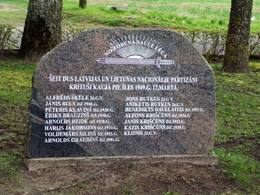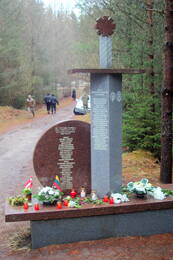Visvalžo Brizgos (Kārļa kraujos) tautinių partizanų grupė
Īlės „Kārļa Krauja“ jungtinė latvių ir lietuvių tautinių partizanų grupė buvo viena didžiausių pasipriešinimo grupių Latvijos teritorijoje 1947–1949 m.
Nacionalinė partizanų grupė „Kārļa Krauja“ buvo suformuota 1947 m. iš asmenų, tarnaujančių latvių legione, iš asmenų, vengusių tarnybos sovietinėje armijoje, arba iš asmenų, kurie dėl kitų priežasčių buvo priversti prisijungti prie minėtos grupės. Grupės vadas buvo Visvaldis Žanis Brizga. 1948 m. spalį „Kārlio Krauja“ grupė susijungė su Lietuvos nacionalinių partizanų grupe, kuriai vadovavo grupės vadas, pravarde „Bize“. Grupė veikė Jelgavos apskrities Zebrenės, Aucės, Bikstų, Slagūnos, Naudytės ir Ilės apylinkėse. Grupėje buvo apie 30 tautinių partizanų narių. 1948 metų spalį Lielauce valsčiuje, netoli Īlės, miškininkų grupė pastatė uždarą, gerai užmaskuotą požeminį bunkerį, kurio matmenys 9 x 6 m, su dviem išėjimais, o apylinkes užminavo nuotoliniu būdu valdomomis minomis. Pagal dydį tai buvo didžiausias nacionalinių partizanų bunkeris Latvijoje. Grupės gyvavimo metu buvo atlikta apie 20 antisovietinių akcijų. 1949 m. kovo 17 d. Latvijos TSR Valstybės saugumo ministerijos kariai apsupo „Kārlio Krauja“ grupės bunkerį Jelgavos rajono Aucės valsčiaus miško masyve, 300 metrų į šiaurę nuo „Priedaišių“ namų. „Kārļa Krauja“ grupės puolimas buvo kruopščiai suplanuotas ir jau patvirtintas 1949 03 11. Kaip liudija SSRS Valstybės saugumo ministerijos (VDM) vidaus kariuomenės 5-osios divizijos vadas generolas majoras P. Ļeontjevas, 1949.g.16.03. Patvirtintame puolimo plane dalyvavo 760 VDM karių dalinys, kuriame buvo 261 Latvijos teritorijoje dislokuotas 5-osios VDM divizijos karys; 36-ojo ir 32-ojo pulkų kariai ir karininkai, iš kurių 600 – blokavimo grupėje, 120 – žvalgų grupėje, 40 – atsargos grupėje. VDM kariuomenės dalinys į puolimo zoną atvyko 13.00 val. 1949 03 17. 5:00 val., 35 sunkvežimiai. Pirmiausia buvo atlikta rajono blokados operacija. Žvalgybos grupė į starto poziciją atvyko 7.30 val., puolimas prasidėjo 8.00 val. Apie 9:00 val. 120 žmonių smogiamoji grupė aptiko gerai užmaskuotą bunkerį, kurio praėjimų ilgis siekė 45 m, aplinka 15-20 m spinduliu buvo užminuota nuotoliniu būdu valdomomis minomis. Bunkerį aptikusi ir prie jo priartėjus smogikų grupei, bunkeryje kartu su sargybos postu buvo 24 jungtinės Latvijos ir Lietuvos nacionalinių partizanų grupės nariai. Vakare iš bunkerio buvo išėję 3 grupės nariai, vadas Visvaldis Brizga, Juris Krusts ir Reinis Hercas. Nacionaliniai partizanai bunkeryje pradėjo mūšį iš abiejų išėjimo liukų ir susprogdino 42 minas, likusias 28 minas puolimo metu neutralizavo sapieriai. Per penkias valandas trukusį mūšį, dviejose vietose susprogdinus bunkerio stogą, užpuolikams pavyko priversti pasiduoti likusius gyvus nacionalinius partizanus, įmetant į bunkerį rankines granatas ir bandant jį padegti. Po muštynių buvo suimti 9 grupuotės nariai (7 latviai ir 2 lietuviai), tačiau muštynių metu krito 15 (8 latviai ir 7 lietuviai), kai kurie iš jų nusišovė. Užpuolikų nuostoliai: lengvai sužeisti - 2, sunkiai sužeisti - 2, o nuo sužalojimų mirė - 2 VDM kariai.
https://www.historia.lv/video/iles-bunkurs-1949g-17marta-kaujas-rekonstruktsi
https://www.lvm.lv/jaunumi/2460-nacionalo-partizanu-bunkurs-iles-mezos
Zihmanis.M. Ten miške, mažame bunkeryje//Uždėjau ežiukui ant galvos., Ryga, 1993 m.
Bajars.V. Jis buvo vienas baisiausių.//Latvijas avīze., 2006 m. balandžio 18 d.;
Strode.H. Latvijos nacionalinių partizanų karas III., Ryga., 2003 m.
Strodas.H. Latvijos nacionalinių partizanų karas, Ryga, 1999 m.
Strode.H. Latvijos nacionalinis partizaninis karas I., Ryga .1996.,
Susijusi laiko juosta
Susijusios temos
Susijusios vietos
The grave of the brothers of the national partisans of Íle in the Virkus cemetery of Birze parish
The Īle National Partisan Brothers' Cemetery in the Virkus cemetery of Bērze parish was established on November 14, 1992, when 15 partisans who fell in the Battle of Īle on March 17, 1949, were buried here. This was possible after on July 18, 1992, the National Guard, together with the organization "Daugavas Vanagi" and the Latvian history research working group "Ziemeļblāzma", with the participation of representatives of other nationally-minded organizations, exhumed the remains of 15 Latvian and Lithuanian forest brothers buried in a blown-up partisan bunker in the Īle forest district of Zebrene parish.
The memorial stone to the national partisans who fell in the Battle of Īle was unveiled on May 29, 1993. It was designed by Alfons Kalniņš ("Edgars"), one of the surviving participants in the battle of March 17, 1949. The regular-shaped granite slab depicts a sword and a rising sun, and is engraved with the names of 15 fallen national partisans and the inscription:
“The sun rose from the sword. Here lie the Latvian and Lithuanian national partisans who fell in the battle of Īle on March 17, 1949.”
Īle National Partisans’ Bunker
The bunker is located in Zebrene municipality, less than 1km from the P104 Biksti - Auce road.
The largest bunker in the Baltic States was built in 1948 in the forests of Īle by the partisans of the united Latvian-Lithuanian group to continue their fight against the Soviets. The 27-strong group was led by the young commander Kārlis Krauja (real name Visvaldis Brizga).
On 17 March 1949, the 24 partisans, who were in a bunker at the time, fought their last battle against the 760-strong force of the Ministry of State Security, or Cheka. 15 guerrillas were killed, nine were captured and deported to Siberia with their supporters.
In 1992, the Home Guards, together with the Daugava Hawks and representatives of patriotic organisations, dug up the bunker, collected the bones of the fallen fighters and buried them in the Virki Cemetery in Dobele. A White Cross, a memorial stone and a granite stele were erected at the bunker.
In the mid-1990s, the outline of the bunker was already traced and reinforced with internal walls, but it was not until the 60th anniversary of the battle that the bunker was rebuilt exactly as it was before it was blown up. Many supporters and volunteers helped to make it happen.
Inside the bunker you can see a stove, a table and narrow benches on which the partisans slept. There are information boards, memorial stones with the names of the partisans and their supporters.
There is a resting place and a toilet.







